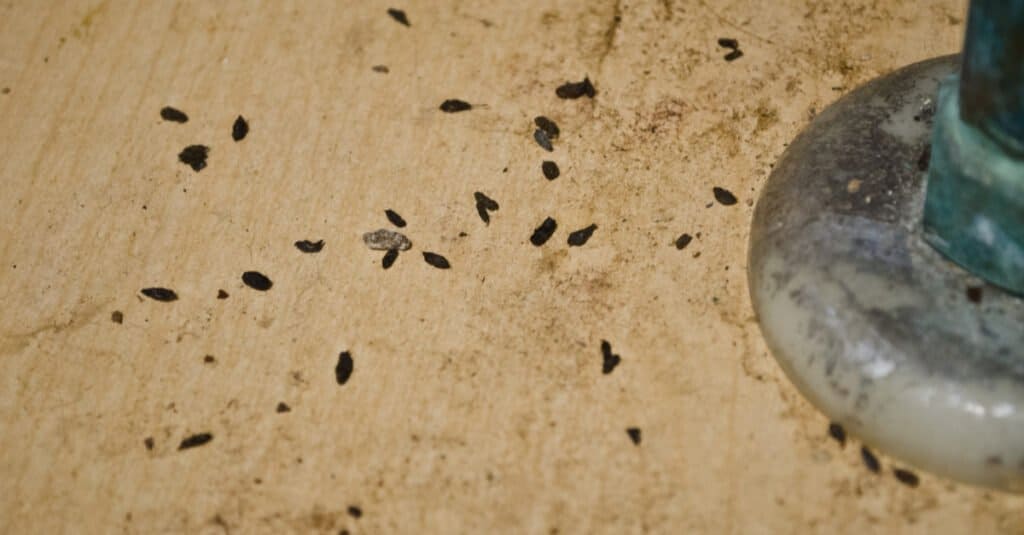Is there an unwanted intruder in your house? You may be worried it is a pest slowly taking up space and eventually compromising your health. Poop is the best way to identify what kind of animal is taking up residence in your home.
Now, you can only remove the pest if you know exactly what the intruder is. So, let’s take a look at some key differences between chipmunk and mouse poop to better judge your next steps.
Comparison Table of Chipmunk Poop vs. Mouse Poop
| Chipmunk Poop | Mouse Poop | |
|---|---|---|
| Size | 0.4 inches long | 0.8 inches long |
| Appearance | Shiny, pale, and soft | Shiny, wet, and will become hard after a few hours |
| Shape | Rice-shaped pellets | Rice-shaped pellets |
| Amount | 2-3 pellets at a time | 4-5 pellets at a time |
| Color | Varies from Brown to Black | Black |
Major Differences Between Chipmunk Poop and Mouse Poop

Chipmunk poop is shorter and paler than mouse poop.
©RT Images/Shutterstock.com
The most significant difference between both animals’ droppings is the color and their appearance. However, it will not be visible until you take a closer look at it. The chipmunk poop will be shorter, paler, and smaller in amount.
Size
The droppings of both a chipmunk and a mouse are similar. Both are easily distinguishable from rat poop which is larger. The chipmunk droppings are similar to the size of rice grains, around 0.4 inches long. The mouse poop, on the other hand, is nearly 0.8 inches long. So, yes, chipmunk poop is around 1/4 of an inch smaller than mouse droppings.
Appearance
Chipmunk and mouse droppings look very similar at first glance. They both are shiny and have a wet surface. However, the same may not be said for mouse droppings as they are only shiny when it is fresh. Fresh poop means that the mouse recently egested (pooped).
Another thing that serves as an identifier is the texture. Chipmunk poop will remain soft even after hours. However, mouse poop will turn hard after some time. In addition, you can smell mouse poop, unlike chipmunk poop which may not smell at all. This is why it is easier to tell if your house has a mouse.
Shape
You will find the shape of both the poops to be quite similar. Chipmunk poop is more like a grain of rice. It is shorter than rat droppings but resembles a pellet shape. It has long, pointy ends and a strong middle.
Mouse droppings are also similar. They are in the shape of pellets, only slightly larger than chipmunk droppings. That is why they are harder to separate from chipmunk droppings unless seen at a closer angle.
Amount
The amount may vary for both the mouse and the chipmunk. However, mice droppings are far greater in amount than chipmunk poop on average.
The chipmunk may excrete around two to three pellets at a time. In contrast, a mouse can defecate four to five pellets at a time. But here is the interesting part: it can poop around 50 to 70 pellets in a single day. This number may even exceed 150 pellets in a day. That is a lot!
The thing about chipmunk poop is that it is hard to find. Due to the small number, negligible smell, and presence in hidden areas, it can become tough to come across chipmunk droppings. But mice droppings will be all over the house.
Color
The color of a chipmunk’s poop depends on what it ate. Since it usually eats fruits and nuts, its poop may be any shade from brown to black. It’s usually a paler shade. Mouse droppings, on the other hand, are black in color. That is not a surprise as mice tend to eat anything and may even be found near the garbage.
Is Chipmunk Poop or Mouse Poop Dangerous?

Mouse poop is about the size of a grain of rice at 0.4 inches long.
©Pegasene/Shutterstock.com
This must not be your first thought but it is a concern you should not take lightly. Be it chipmunks or mice, you cannot remove the idea that poop can be both infectious and dangerous to your health.
Although it is hard to find the chipmunk poop since it is hidden even if you come across it, do not go near it. Both animals have a different diet but that does not mean the bacteria and viruses are not there. Some of the diseases that you can catch from chipmunk and mouse droppings are as follows.
Leptospirosis
Leptospirosis is a bacterial disease. It spreads through the dust in the air. Some of the fatal causes that you can get through the disease are kidney damage, liver damage, and even death if you are not careful. It can affect both humans and other animals, so it is best to keep your pets at bay as well.
Salmonellosis
This disease is caused by a bacteria known as Salmonella. You may observe cramps, stomach pain, diarrhea, and fever. It is not fatal to have Salmonellosis but it can be a painful experience.
Hantavirus
This disease is the most common and highly contagious disease. It can happen to anyone who has been near the droppings or even the urine of a rodent. The disease can cause severe respiratory distress if the person does not take care of it by seeking treatment and medical advice.
Bubonic Plague
This is a disease of the old days yet it is still found in some cases. Through this disease, you might suffer from the swelling of lymph nodes. But on rare occasions, it can cause death.
How to Clean Chipmunk and Mouse Droppings?
The method is more or less the same for both the chipmunk and mice droppings. All you need to do is follow these simple steps:
Wear Protective Gloves
The first step is to stay protected. For that, you should wear gloves so that no droppings can touch any part of your body. It is best to stay at a distance to avoid any exposure. Try wearing a mask to prevent the air-borne particles from bringing any bacteria to your side.
Mouse droppings will be easier to clean than chipmunk droppings. The reason is that chipmunks are hidden and poop in places where the faint smell of their poop cannot reach predators. However, if you do spot droppings, its nest will be near as well. So, you might need to call an exterminator.
Sweep The Droppings
The next step is to clean. First, spray disinfectant on the poop. This comes in handy when you are sweeping mice droppings. The reason is that the mouse poop is wet and can leave its residue lying around. In addition, the air-born particles may catch the dust along with the particles of the mouse poop.
This is to simplify the process and help you in sweeping. Secondly, use paper towels or a newspaper to pick up the poop and dispose of it in your garbage cans.
Spray Disinfectant on Affected Area
The last step is to clean the place where the droppings were moments ago. Take any reliable disinfectant solution and spray it on the affected area. This is important because the bacteria may find their home on these sites and eventually cause unwanted diseases in your homes.
The photo featured at the top of this post is © ChristinLola/Shutterstock.com
Sources
- Insect Cop, Available here: https://insectcop.net/chipmunk-poop/
- Hama Pest Control, Available here: https://hamapestcontrol.ca/rat-pest-control/chipmunk-poop-vs-mouse-poop/#:~:text=Chipmunk%20poop%20will%20resemble%20a,droppings%20are%20more%20pellet%2Dshaped.
- Thomas Pest Services, Available here: https://www.thomaspestservices.com/blog/post/everything-you-need-to-know-about-mouse-poop#:~:text=It%20is%20not%20uncommon%20for,a%20lot%20of%20poo%2C%20folks.
- Small PetsX, Available here: https://smallpetsx.com/chipmunk-poop-vs-mouse-poop/
- Pest Control Hacks, Available here: https://pestcontrolhacks.com/chipmunk-droppings/
Thank you for reading! Have some feedback for us? Contact the AZ Animals editorial team.







